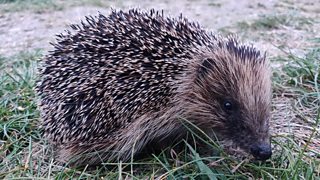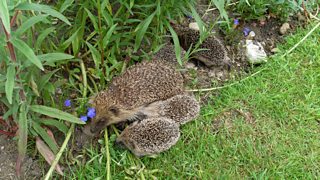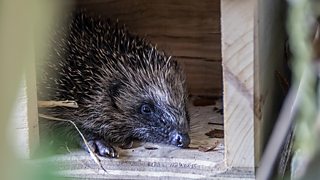The hidden lives of hedgehogs
People's Trust for Endangered Species (PTES)
Partner organisation of the Watches
By Grace Johnson, Hedgehog Officer at Hedgehog Street
Hedgehogs are an iconic part of UK nature and beloved by British people, with our prickly friends featuring on everything from mugs and t-shirts to ‘hedgehugs’ cushions. But when it comes to hedgehogs in the flesh, sadly few people have actually seen one of these solitary, nocturnal mammals. Rapidly declining numbers mean they’re no longer a common sight in the UK. We do know however, that gardens can be vital habitat for hedgehogs and are providing strongholds for existing populations. But what do they actually use our gardens for? Hedgehogs have a seasonal lifecycle, so the answer depends on the time of year…

Image by Natalie Plaxton
Springing into action
In spring, hedgehogs need to feed up in order to replenish their lost fat reserves following hibernation. As a generalist species, hedgehogs feed on almost anything they come across on their travels; insects, fallen fruit, carrion and even bird’s eggs feature on a hedgehog’s menu.
Hedgehog courtship and subsequent mating occurs in spring and summer, with most activity being in May and June. Hedgehog courtship is a lengthy affair and involves the male circling the female, while she makes loud ‘huffing’ sounds - you may have a better chance of hearing hedgehogs rather than seeing them during ‘the rut’! Eventually the female will allow the male to take position, and will adopt a special flattened body position to facilitate copulation. Both male and female hedgehogs have been found to be promiscuous, mating with multiple partners throughout the season. Hedgehog litters may therefore even have multiple fathers.

Image by Mark Boulton
Male hedgehogs may display aggressive behaviours during spring, as competition for food and females intensifies. One hedgehog will charge another, and attempt to roll them out of the way. Human onlookers are often shocked at the brutality of these encounters but rest assured it’s a normal part of hedgehog life.
Summer loving
Males don’t hang around to help with raising the baby hedgehogs, known as hoglets. Female hedgehogs will build a special summer nest in which to rear her little ones, where they will stay for 3-4 weeks before joining her on foraging trips into the outside world. Juvenile hedgehogs will become independent around 6-8 weeks old.

Image by Paula Youngman
An interesting behaviour seen in hedgehogs is known as ‘self-anointing’, whereby hedgehogs cover their spines in foamy saliva using their tongue. The purpose of this behaviour remains a mystery, with theories ranging from disguising their scent from predators, to enticing mates.
Autumn nesting
Hedgehogs spend the autumn months building up fat reserves for hibernation, so finding food is extremely important as winter approaches. They are often seen in gardens foraging for food or visiting a dedicated feeding station. While well-meaning hedgehog fans have traditionally left out bread and milk, this is of little nutritional value and can even make them unwell. Meaty cat or dog food (or specialist hedgehog food) and a shallow dish of water will increase your chances of a hedgehog sighting in the garden.
In the run-up to winter, hedgehogs will also start building a hibernation nest, or hibernacula. While summer nests are often temporary and somewhat ‘flimsy’, a hedgehog will spend time ensuring its winter nest is strong and durable. Man-made hedgehog houses are popular for hibernation, or a hedgehog will arrange sticks, leaves, grass and other natural materials into thick walls with a spherical chamber inside where the hedgehog will stay over-winter.

Image by Hazel Seal
Hunkering down for winter
In the cold winter months when invertebrate food sources are scarce, hibernation is a hedgehog’s best survival strategy. It is thought that hibernation is triggered by a combination of food and environmental temperatures reducing, and can last weeks at a time. Hedgehogs periodically rouse from hibernation when temperatures rise, or in an extended period of mild weather they may not hibernate at all. During hibernation a hedgehog drops its body temperature down to match its surroundings, and slows down all other processes like breathing and heart rate. All of this serves to conserve energy reserves until temperature and food resources improve.
Hedgehogs After Dark: This summer, discover the hidden lives of hedgehogs and record what behaviours you see!
This summer Hedgehog Street has launched ‘’ to help us discover the hidden lives of hedgehogs. Between now and the 26th July, hedgehog behaviours spotted in your garden can be logged online to help build a picture of how hedgehogs use domestic gardens, and whether certain behaviours are more common than others.
Those with a wildlife camera can also submit their best videos, which will be shared on social media and the to raise awareness of the plight of these charismatic yet vulnerable creatures. is a joint campaign between and the

Image by Cate Barrow
